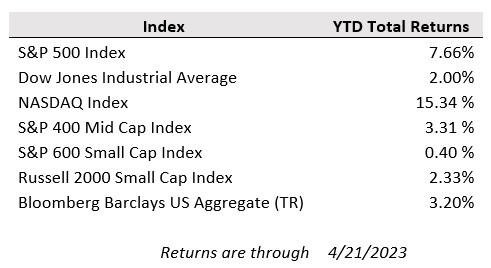U.S. equities broadly moved sideways last week amid quiet trading activity as investors awaited a sharp pick-up in first quarter corporate earnings reports set to occur in the week ahead. Equity market volatility fell to the lowest levels since November of 2021 last week with little reaction to another modest backup in yields, with the 2-year back near 4.20% and 10-year near 3.60%. Federal Reserve board members continue to reiterate the higher-for-longer interest rate mantra and have set the stage for another 0.25% rate hike in May, which would bring the Fed funds rate to over 5%. Markets reflect expectations for it to be the last rate hike with rate cuts forecast in the second half of the year, flying in the face of the Fed’s communicated higher-for-longer forecast.
While real-time U.S. economic data like nonfarm payrolls and consumer spending have remained resilient, markets are pricing in expectations for rate cuts in the second half of the year due to growing weakness in forward-looking economic indicators. The Conference Board Leading Economic Index (LEI) for the U.S. fell by 1.2% in March to 108.4 (2016=100), following a decline of 0.5% in February. The LEI is now down 7.2% year-over-year, the sharpest decline since April of 2020, which indicates growing potential for a recession in the next 12 months.
However, not all recent economic data has painted such a bleak outlook. April data indicated a faster rise in business activity at firms based in the U.S., according to the latest flash PMI data from S&P Global. Output rose at the sharpest pace in almost a year, as stronger demand conditions, improving supply and a steeper uptick in new orders supported the expansion. Solid growth in activity was seen across both the manufacturing and service sectors. The headline S&P Global Flash US PMI Composite Output Index registered 53.5 in April, up from 52.3 in March, to signal the quickest upturn in business activity since May 2022. The increase in output was the third in as many months. The faster rise in activity was broad-based, with service sector firms registering the sharper rate of growth. Where a rise in activity was noted, firms linked this to greater customer confidence and a stronger uptick in new orders. Some companies also noted that an improvement in their ability to hire staff had boosted output.
Investors will also be keeping a close eye on developments in the standoff in Congress on the nation’s debt ceiling. House Republicans have unveiled a proposal titled the Limit, Save, Grow Act that would return the government’s discretionary spending to fiscal year 2022 levels, cap annual spending growth at 1% for a decade and raise the debt ceiling until March 31, 2024, or until the national debt increases by $1.5 trillion, whichever comes first. The bill will face opposition in the Democratic-controlled senate. The U.S. Treasury has been operating under extraordinary funding measures since the country hit its $31.4 trillion debt limit in January. Such measures may run out as early as June based on weaker than expected tax collections, thereby adding more urgency to the negotiations.
The week ahead looks to be an eventful one as we have entered the heart of first quarter earnings reporting season. Altogether, roughly 35% of the companies in the S&P 500 will report results this week, including some of the bigger names in the market such as tech heavyweights Amazon, Alphabet, Microsoft, and Meta.


